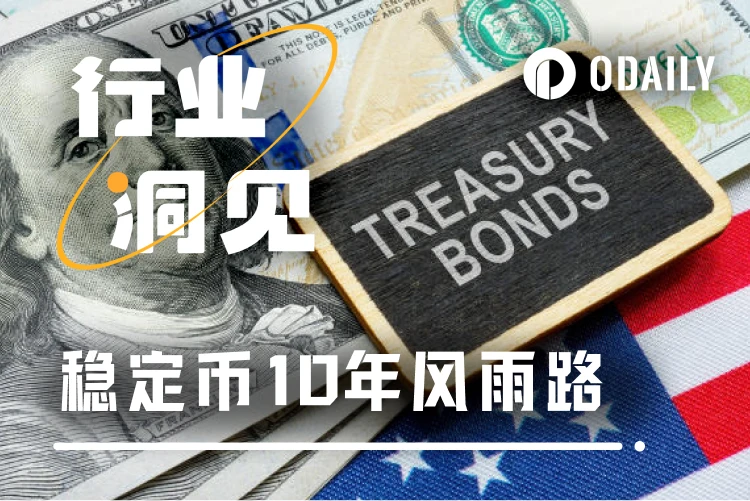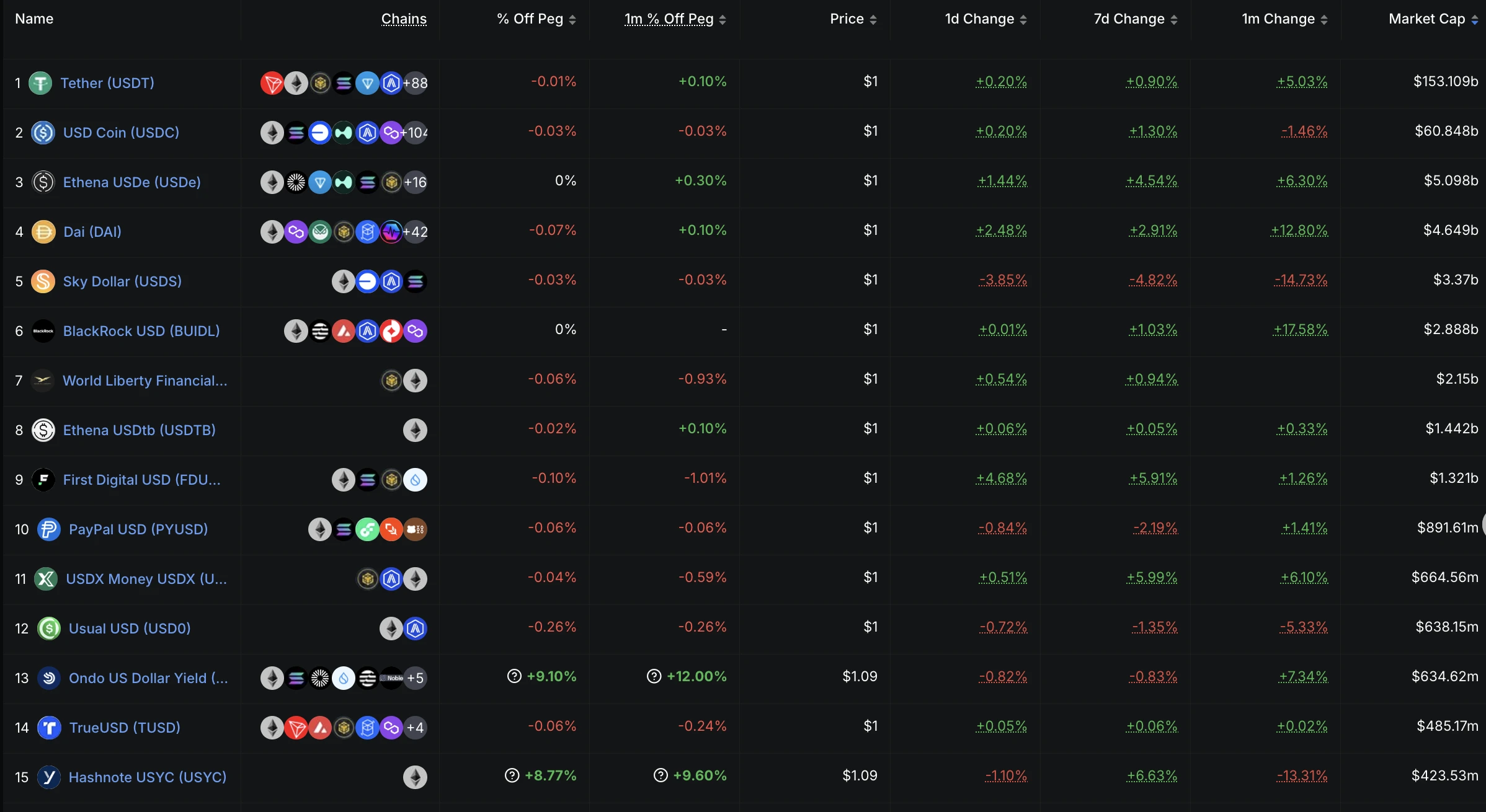Original | Odaily Planet Daily ( @OdailyChina )
Author: Wenser ( @wenser 2010 )

As the price of BTC approaches a new high of $112,000, the US stablecoin regulatory bill Genius Act is also ready to go, and the crypto industry is further deeply coupled with the global economic system. At this time, people realize that the payment system is the crown of the crypto industry, and BTC is the pearl on the crown. This is also one of the reasons why PayFi, U card, and RWA have become the battleground for exchanges and crypto project parties to gather as the mainstream process of crypto assets accelerates. In the future, independent payment solutions based on real-world sub-industries may become possible.
In this article, Odaily Planet Daily will briefly sort out and discuss the past development history and future trends of the stablecoin industry.
Stablecoins: The old 10 years of cryptocurrencies originating from USDT (2014-2024)
In 2008, an article titled Bitcoin: A Peer-to-Peer Electronic Cash System appeared on the P2P Foundation website. Its author was signed as Satoshi Nakamoto, who was later revered as the ancestor of the crypto industry. At that time, the world economy was slowly rebuilding after the 2008 subprime mortgage crisis that broke out due to severe US dollar inflation. There is no doubt that the original intention of the birth of BTC was to solve the chronic problems of the centralized currency supply system and the lengthy, rigid and inflexible global financial payment system.
But what was unexpected to many crypto OGs, including Satoshi Nakamoto, was that what ultimately fulfilled BTCs peer-to-peer payment wish was not BTC, which held high the banner of decentralization, but various stablecoins that were strongly tied to the US dollar and US bonds.
The rise of USDT: Surrounding the city from the countryside, and seizing the market with use cases
Looking at the history of Tether’s development, we can roughly classify it into a “three-step strategy”:
(1) From Crypto Blood to Crypto Oil
In October 2014, Tether was founded. At that time, its core product was the stablecoin USDT issued based on the Bitcoin Omni protocol.
In February 2015, USDT was launched on Bitfinex, the largest Bitcoin trading platform at the time. Tether CEO Paolo Ardoino is also the CTO of Bitfinex. The two companies have always been regarded as brother companies by the outside world due to the high overlap of team members.
In 2018, Tether issued USDT based on the ERC 20 standard on Ethereum. USDT under this standard is compatible with the original protocol, further improving its convenience of use. Since then, Tether and USDT have taken advantage of the development of the Ethereum ecosystem and have gradually penetrated into the body of the crypto ecosystem like crypto blood.
In 2019, TRON and Tether successfully married . Since then, TRON has been soaring on the road to becoming the leading stablecoin network ecosystem. The former has become a heavyweight cooperative network that accounts for more than one-third of the USDT issuance. TRON founder Justin Sun also made TRON one of the cryptocurrency infrastructures through the early coin distribution strategy.
It can be said that after the early redemption fee profit model was successfully verified, Tether has established its own competitive barriers and business model through USDT, and has gradually become a transaction equivalent to oil raw materials in the crypto ecological network.
(2) From encryption to more than encryption
As time enters 2020, with the outbreak of DeFi Summer, the market value of stablecoins has been rising. Tether and USDT are the ones who have seized the opportunity to reap the benefits. Tethers ambition is naturally no longer limited to the crypto world, but is gradually expanding to a larger range.
As we mentioned in the article The market value of the first stablecoin USDT hits a new high, revealing the 100 billion business empire behind Tether : USDTs usage scenarios include general equivalents of cryptocurrencies, alternative currencies in inflationary regions, and major payment tools for cross-border trade, etc. In addition, after Tether has obtained massive profits, it has further extended its hands and feet to the entire world economic system through various investments, acquisitions, U.S. debt reserves, gold reserves, and BTC reserves, strengthening its connection with the outside world of cryptocurrencies. This is also one of the important reasons why USDT has been criticized as a money laundering accomplice. After all, money never sleeps, and the same is true for USDT.
(3) From means of payment to value storage
In 2021, after reaching a settlement with the New York Attorney Generals Office (NYAG) and paying a $41 million fine to the U.S. Commodity Futures Trading Commission, Tether has phased out the biggest obstacle on its road to development. Since then, the value of USDT has gradually upgraded from a means of payment to a store of value. After experiencing previous incidents such as the de-anchoring storm and the reserve asset Fud, USDT issued by Tether has become one of the few objects of hoarding in the high-risk and high-volatility crypto market-the other object is BTC. In particular, the continuous purchase of U.S. bonds, the market position and brand recognition tied to the U.S. dollar at a 1:1 ratio have finally been successfully recognized by the crypto community, and the billions or even tens of billions of dollars in profits each year have provided it with the confidence to win the twin dollar brand.
From a crypto project that once grew wildly to the dominant stablecoin today, Tether and USDT have staged a wonderful drama of surrounding the city from the countryside and seizing the market with use cases.
USDC’s Second Path: Centralized Development, Crypto IPO
Unlike the USDT issued by Tether, Circle, which was founded by Coinbase, and its stablecoin USDC have taken a completely different path: everything is built for compliance.
Apart from the regular U.S. Treasury reserves, Circles profit model is undoubtedly more fragile than Tethers. After all, partners such as Coinbase and Binance can eat up more than half of its profits. This is also one of the important reasons why it has been pushing for crypto IPOs after Trump took office. Only by seizing the existing advantages of compliance and expanding its base from the cryptocurrency field to the traditional financial market in a timely manner can it obtain stronger bargaining power and obtain stronger funds, resources and even policy support in subsequent market competition.
For more information about Circle, please see Odaily Planet Dailys article Circle IPO may be delayed, what is the valuation of the first stablecoin stock?
In addition to the two market giants USDT and USDC, from the early market TrueUSD (TUSD), Circle Coin (USDC), Gemini Dollar (GUSD), Paxos (PAX), to other stablecoin projects that still occupy a certain market today, such as DAI (MakerDAO), USDS (Sky), USDDe (Ethena), PYUSD (PayPal), RLUSD (Ripple), USD1 (WLFI) , etc., the competition for this lucrative cake is undoubtedly becoming increasingly fierce. Who can truly remain invincible or become the ultimate winner still needs to be tested by regulatory policies and verified by time.

https://defillama.com/stablecoins
The US Genius Act has set off a wave of stablecoin regulation: filling the last piece of the crypto regulation map
For all stablecoin projects, the Genius Act, a stablecoin regulatory bill that the U.S. Senate recently voted to pass, is undoubtedly the sword of Damocles hanging over their heads. After Bitcoin spot ETF and Ethereum spot ETF have become part of the traditional institutional capital allocation positions, this bill will undoubtedly fill in the last piece of the Trump administrations crypto regulation map.
Specifically, in my personal opinion, the main purpose of the Genius Act is to:
1. Ensure the hegemony of the US dollar. As a loyal supporter of America First, the core purpose of Trump and his government members and even the Democratic Party members is still to ensure the political and economic hegemony of the United States, and the main medium to achieve this is the US dollar. Stablecoins that are pegged to the US dollar at a 1:1 ratio are undoubtedly one of the best tools.
2. Ensure that the operation of the stablecoin system is under the jurisdiction of the United States. Now that the crypto-friendly environment has become a foregone conclusion, the United States is becoming a hot spot for crypto again, which will help the United States take the initiative in the stablecoin operation system and regulatory policy formulation. At that time, just like the foreign trade regulations in the past, the United States will achieve comprehensive suppression of the global crypto economy and even cross-border trade through the stablecoin system.
3. Ensure partial security of the crypto-financial system. This is one of the important reasons why the Genius Act has been positively affirmed by many industry professionals and representatives of the traditional financial industry. The mandatory 1:1 full asset reserve and the prohibition of misappropriation and re-pledge, the release of a reserve report at least once a month and the introduction of high-frequency information disclosure for external audits, the banking-level regulatory license after the circulating market value exceeds US$10 billion, and the introduction of custodians will add one safety lock after another to the stablecoin track. Of course, as for whether the door behind the lock is solid, this is another question.
4. It greatly opens up the imagination space of the RWA track, and the on-chain and off-chain worlds are more closely integrated. It can be said that stablecoins are the earliest RWA products, and the real-world assets they are bound to are US dollars. With the gradual implementation of the Genius Act, the introduction and implementation of RWA-related bills are not far away. Compared with the current cryptocurrency market of over 3 trillion US dollars, it will be an asset market of tens of trillions of dollars.
In this regard, the Genius Act will provide policy dividends for the US government and the US economy to develop the digital economy, tap the potential of digital assets, and encourage the development of crypto projects, giving birth to a number of crypto projects with great development prospects and the teams behind them. The geniuses who will bear the future of crypto may be hidden among them.
Cryptos new decade: Finance is still the main line, and crypto concept stocks and stock tokenization have great potential
Looking at the year 2025, the proportion of crypto people in the global population has peaked, and cryptocurrency investment is still a game for a few people. But on the other hand, in a commercial society, everyone has a natural need to exchange goods, where goods can be tangible products and items, or intangible labor, virtual assets, digital IP, etc. Therefore, based on such needs, more convenient, low-cost, and more secure crypto payments will eventually penetrate into everyones daily life.
In the next 10 years (2025-2035), the main line of the cryptocurrency industry may gradually shrink from multiple tracks and fields that have been falsified by the market to the financial field. As a result, crypto concept stocks and stock tokenization generated based on crypto IPOs will become new fronts in the crypto industry.
In some ways, the stocks of listed companies such as Strategy, Sol Strategy, and Metaplanet have become dual carriers of crypto concept stocks and stock tokenization. After the value of BTC is recognized on a larger scale or even at a higher price, their potential value will be further released.
Of course, within the visible range, the ETH ecosystem and Solana ecosystem are still the mainstream choices in the current industry.
Conclusion: Satoshi Nakamoto’s “legacy” was finally realized, but the way it was realized was contrary to the original intention
At the end of the article, we still cannot avoid Satoshi Nakamoto, the founder of Bitcoin, the crypto giant who has disappeared from the market’s view. The epitome of his “BTC peer-to-peer payment system” is undoubtedly the stablecoin.
However, it is a bit ironic that he, who has the spirit of a crypto-punk, might not have expected that BTC, which was created to fight against the authoritarian governments unrestrained and ever-expanding coinage power, would instead give birth to a more dollar-centered, U.S. debt-backed stablecoin system.
Recommended reading:










